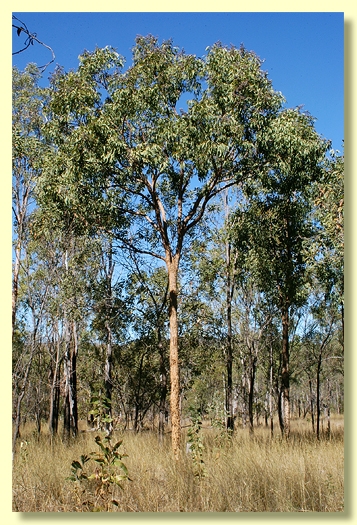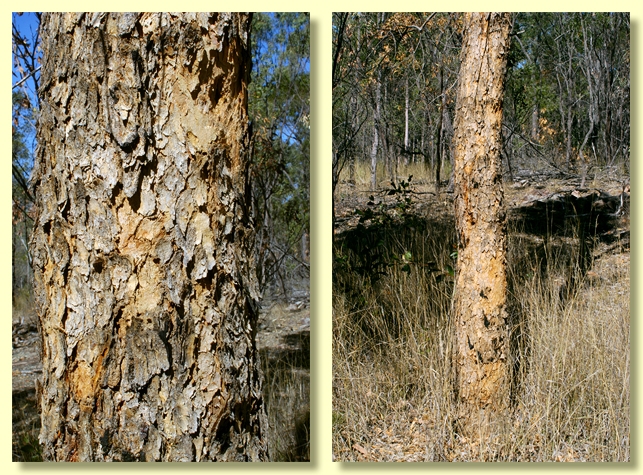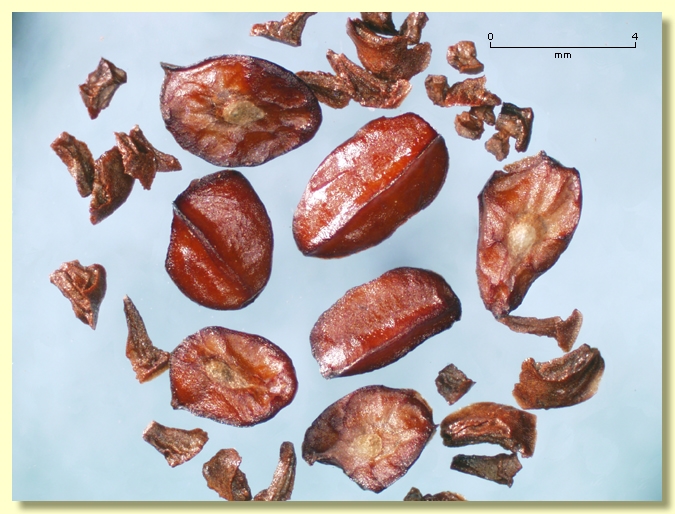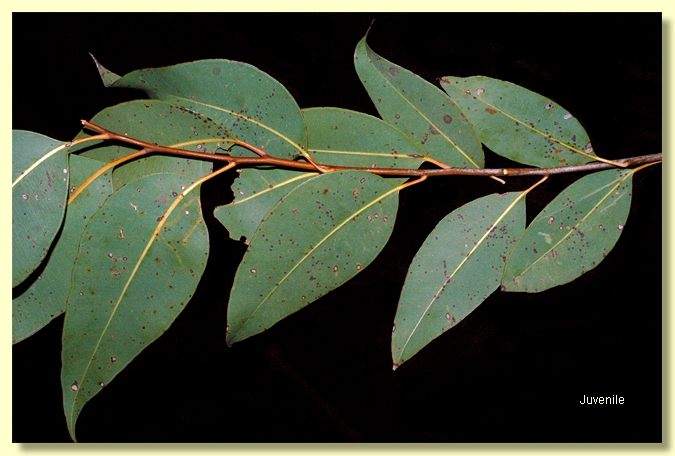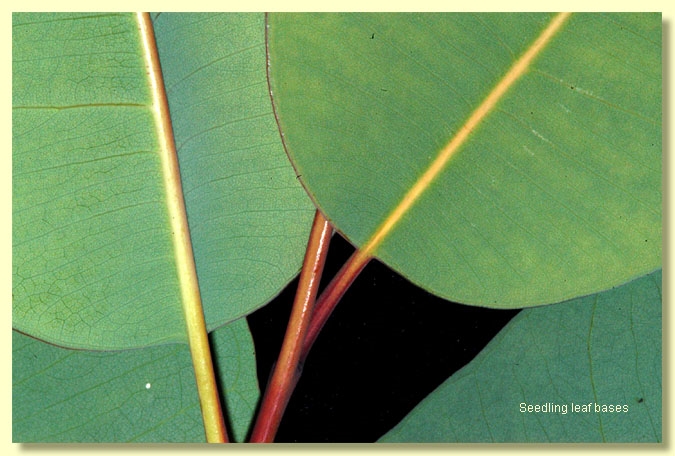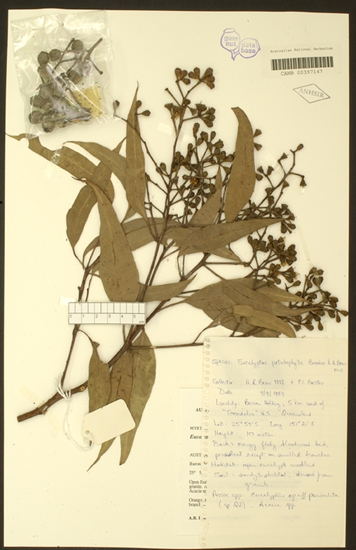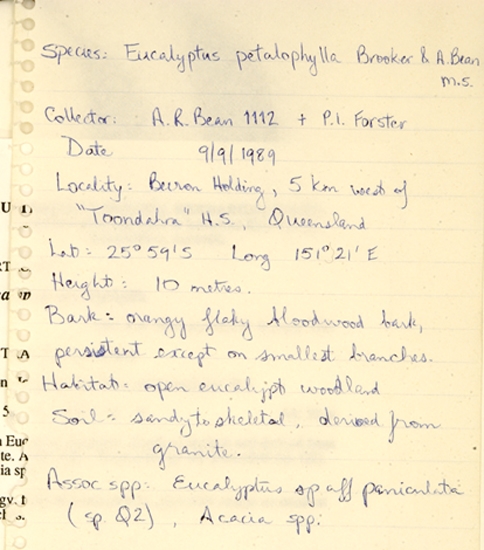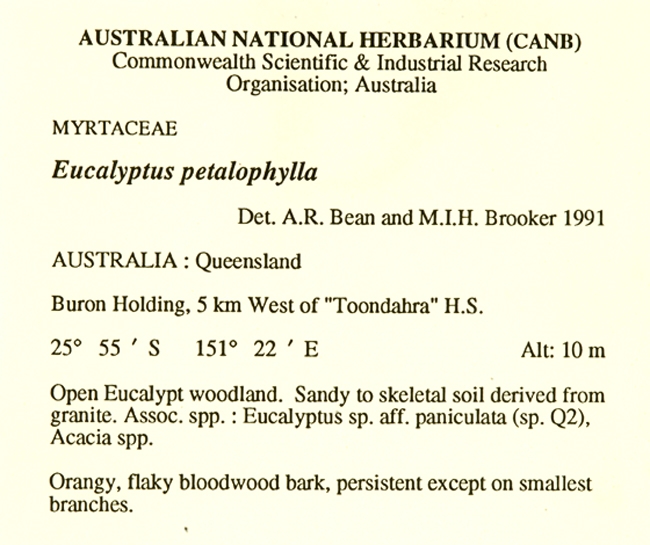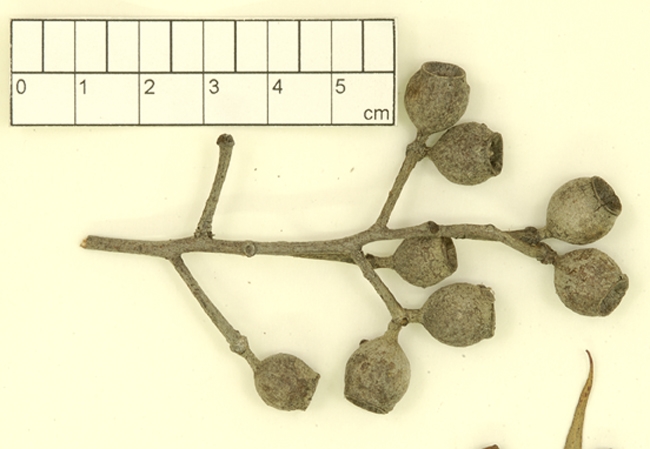Corymbia | Ochraria
Euclid - Online edition
Corymbia petalophylla
Corymbia petalophylla (Brooker & A.R.Bean) K.D.Hill & L.A.S.Johnson, Telopea 6:375 (1995).
Tree to 15 m tall. Forming a lignotuber.
Bark rough to all but the smallest branches, loose, thick, tessellated and flaky, yellow-brown to yellow-orange and yellow-grey.
Branchlets smooth (glabrous); pith contains ± elongated oil bodies.
Juvenile growth (coppice or field seedlings to 50 cm): stem rounded to square in cross-section, predominantly glabrous (setose/scabrid only in very lowest part); juvenile leaves always petiolate, opposite, scabrid and with peltate base for only 1 or 2 nodes, then alternate, glabrous and with normal petiole insertion and truncate to rounded bases, ovate, 7.5–14.5(18.5) cm long, 4–10 cm wide, margin entire or distantly indented, apex pointed, green to grey-green.
Crown entirely of glabrous Adult leaves; leaves alternate, petiole 1–3.8 cm long; lanceolate or falcate, 8–19 cm long, 1.5–4.5 cm wide, flat, base tapering to petiole, apex finely pointed, margin entire, concolorous, dull, grey-green to green, penniveined, densely to very densely reticulate, intramarginal vein parallel to and just within margin, oil glands island, small, scattered.
Inflorescence terminal compound, peduncles 0.7–2.8 cm long, buds 7 per umbel, shortly pedicellate (pedicels 0.1–0.7 cm long). Mature buds obovoid, 0.7–0.8 cm long, 0.4–0.5 cm wide, scar present (outer operculum shed early), operculum flattened to rounded and umbonate, or conical, stamens inflexed, anthers ± oblong, versatile, dorsifixed, dehiscing by longitudinal slits (non-confluent), style long, stigma tapered, locules 3, the ovules arranged in 4 or 5 ± vertical rows on the placentae. Flowers white.
Fruit sessile or shortly pedicellate (pedicels 0.1–0.7 cm long), barrel-shaped to urceolate or truncate-globose, 0.8–1.4 cm long, 0.8–1.2 cm wide, disc descending, valves 3, enclosed.
Seeds brown to reddish brown and shiny, 2.5–6 mm long, boat-shaped with a keel on the smooth and usually cracked dorsal surface, not winged but some seed have a short flange at one end, hilum ventral.
Cultivated seedlings (measured at ca node 10): cotyledons reniform to orbicular; stems rounded in cross-section, setose only to ca node 4–6 then glabrous; leaves always petiolate (to 2.1 cm), opposite until ca node 2–3 then alternate, ovate to ovate to lanceolate, 10–15 cm long, 4–7.9 cm wide, base lobed to truncate then rounded, or becoming peltate for a couple of nodes but by node 9 petiole insertion in lamina reverting to rounded, margin entire, apex pointed, dull, green, ± concolorous, setose only for lowest 6 leaf pairs then glabrous
Flowering has been recorded in September.
A yellow bloodwood tree endemic to south-east Queensland with very restricted distribution in the Eidsvold–Gayndah area. It occurs in low forest on well-drained skeletal sandy soils on rolling hills. Corymbia petalophylla has yellow-orange to yellow-brown to yellow-grey rough flaky-tessellated bark on trunk and branches, dull grey-green crown of fully adult leaves, terminal inflorescences and predominantly glabrous juvenile leaves. The fruit are small.
C. petalophylla occurs adjacent to the south-eastern parts of the distribution of both C. bloxsomei and C. watsoniana subsp. watsoniana in the Gayndah area. Both C. petalophylla and C. watsoniana subsp. watsoniana have dull green to grey green lanceolate crown leaves, but subsp. watsoniana has much larger buds and fruit (fruit 2–3.2 cm long cf. 0.8–1.4 cm long for C. petalophylla). C. bloxsomei has glossy green lanceolate crown leaves and fruit 1.2–1.8 cm long.
MORE ABOUT CORYMBIA
MORE ABOUT YELLOW BLOODWOODS
Corymbia petalophylla: Greek petalos, broad and phyllon, leaf, referring to the broad juvenile leaves.

